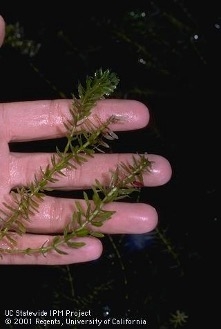
Hydrilla is easily spread since it often breaks apart into tiny pieces that can each produce new plants. It also produces special survival structures on the stems (turions) and in the sediment (tubers). Each tuber can produce a new plant. The tubers can survive up to seven years in the sediment before sprouting, even if no water is present.
What can you do?
Hydrilla can be introduced to new areas on boats, trailers, fishing tackle, and sometimes even waterfowl. Inspect these items and remove any plant material from them before leaving the water. Hydrilla is also commonly sold for use in aquariums. Never dump your aquarium water into waterways or down the drain.
The California Department of Food and Agriculture (CDFA) conducts eradication efforts in multiple counties throughout California. The largest eradication effort is the infestation in Clear Lake which began in 1994. The program has successfully eradicated hydrilla from 15 counties since 1976.
If you find hydrilla, contact your local agricultural commissioner's office or the California Department of Food and Agriculture (CDFA) Pest Hotline: 1-800-491-1899.
Learn more about this invasive aquatic weed by visiting the links below:
- California Invasive Plant Council https://www.cal-ipc.org/plants/profile/hydrilla-verticillata-profile/
- Educational pamphlet on hydrilla https://www.cdfa.ca.gov/plant/npdes/docs/aquatic-weeds/HydrillaPamphlet.pdf
- Hydrilla Eradication Program https://www.cdfa.ca.gov/plant/ipc/hydrilla/hydrilla_hp.html